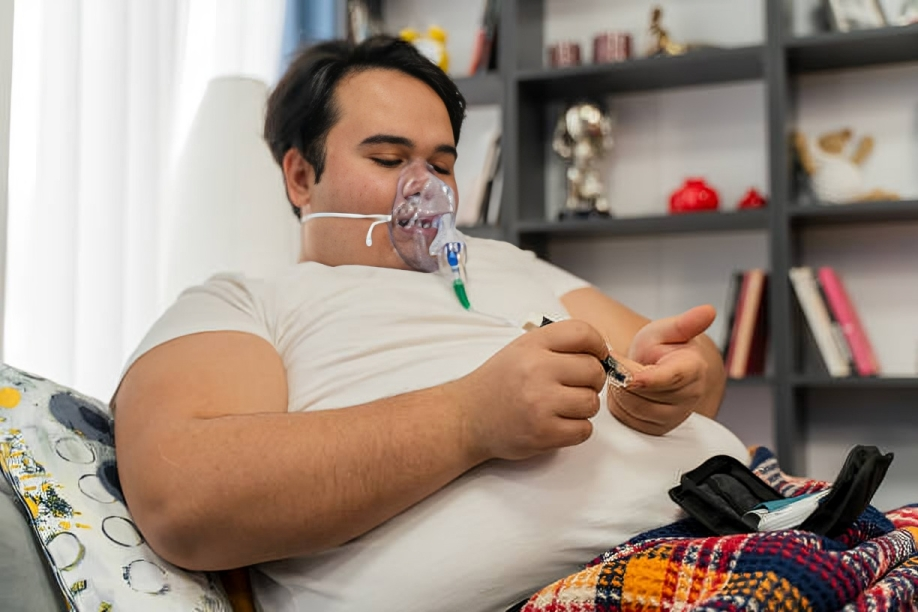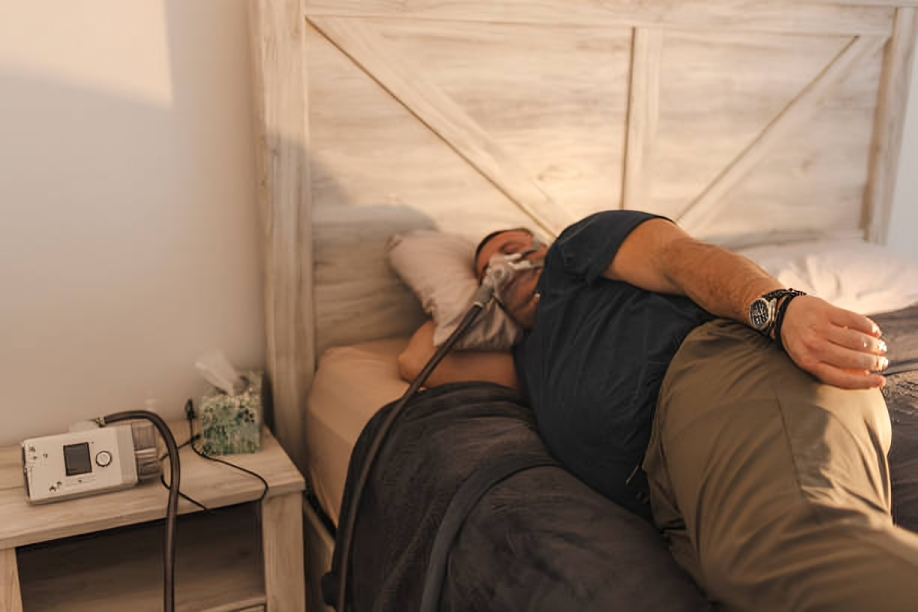Obesity Hypoventilation Syndrome (OHS), also called Pickwickian syndrome, is a serious complication that most commonly involves the obese population. It is characterized by a triad of obesity (BMI more than 40 kg/M2), including hypercapnia (increased carbon dioxide level in your blood), hypoxemia (low oxygen level), and sleep-disordered breathing.
What is Obesity Hypoventilation Syndrome?
Obesity is a worldwide epidemic that is increasing day by day. It is thought to be the mother of illness. It can cause multiple complications, and OHS is one of them. The overall prevalence of obesity in the United States of America (USA) is about 35.5% in males and 35.8% in females.1Ghimire P, Sankari A, Kaul P. Pickwickian Syndrome. [Updated 2024 Feb 3]. In: StatPearls [Internet]. Treasure Island (FL): StatPearls Publishing; 2024 Jan-. Available from: https://www.ncbi.nlm.nih.gov/books/NBK542216/
In this syndrome, the affected person is overweight (BMI greater than 40 kg /m2) and can not breathe easily due to fat overload, which causes daytime alveolar hypoventilation (poor breathing). Hypoventilation on OHS is characterized by a high carbon dioxide level in the blood, a low oxygen level, and breathing problems during sleep in the absence of any other respiratory, metabolic, or cardiac illness. Early diagnosis and treatment are critical for reducing morbidity and mortality risk.
How Common Is Obesity Hypoventilation Syndrome?
The prevalence of obesity hypoventilation syndrome is not well known. However, the prevalence of this syndrome ranges between 0.15-0.16% of the population worldwide. Notably, the prevalence rate is high in obese individuals, about 19-32%. It most commonly occurs in men rather than women. In the USA, it targets black people more than white people. The incidence of OHS is directly proportional to your weight (Body mass index).2Google Scholar. (n.d.). https://scholar.google.com/scholar_lookup?journal=Am+J+Med&title=The+obesity+hypoventilation+syndrome&author=AL+Olson&author=C+Zwillich&volume=118&issue=9&publication_year=2005&pages=948-56&pmid=16164877=gs_qabs&t=1708625272113&u=%23p%3DKIO3i7O4nYgJ
Causes of Obesity Hypoventilation Syndrome
The exact cause of OHS is unknown. However, it is a multifactorial disease. It can be due to an injury to the brain that controls your breathing mechanism.
Severe weight gain can build fats around chest wall muscles (that help in breathing). Due to this, the affected person can not breathe deeply, resulting in poor breathing. Therefore, a person can not inhale fresh oxygen, which causes (hypoxemia) and can not completely exhale carbon dioxide, leading to hypercapnia.

Excess fat on your belly and neck may also interfere with your hormones, affecting your breathing mechanism.3Masa, J. F., Pépin, J., Borel, J., Mokhlesi, B., Murphy, P. B., & Sánchez-Quiroga, M. (2019). Obesity hypoventilation syndrome. European Respiratory Review, 28(151), 180097. https://doi.org/10.1183/16000617.0097-2018
Symptoms of Obesity Hypoventilation Syndrome
Obesity hypoventilation is characterized by poor breathing, resulting in low oxygen and high carbon dioxide (Co2) levels in your blood. The signs and symptoms of OHS are:4Obesity hypoventilation syndrome. (n.d.-b). Temple Health. https://www.templehealth.org/services/conditions/obesity-hypoventilation-syndrome
- Breathing problem (poor or shallow breathing)
- Choking
- Fatigue
- Increased body weight
- Sleep problems
- Morning headaches
- Children have poor school performance
- Daytime sleepiness
- Dizziness
- Depression
- Loud snoring may affect the quality of life of your partner
- Pause during breathing
Obesity Hypoventilation Syndrome – Diagnosis
Diagnosis of obesity hypoventilation syndrome is based on a detailed history, clinical examination, lab investigations, and imaging studies to rule out the other restrictive and obstructive lung diseases and metabolic abnormalities.
History:
Your doctor will take a history to diagnose this disease. Most of the time, this syndrome is confused with other respiratory pathologies such as COPD. During history, your doctor will ask some questions, including your presenting complaints, weight changes (body mass index), family history, previous medical history, any comorbidity, and details about your previous treatments.
Physical Examination:
During a physical examination, your doctor will examine your body completely. He will check for any signs of cyanosis (bluish coloration of the lips and periphery due to low oxygen), auscultate your chest to check for signs of cardiac failure (cor pulmonale), examine your legs to look for signs of edema, and check for signs of extreme sleepiness.
Your doctor will also check your oxygen saturation and pulse using a pulse oximeter applied to your finger.
Laboratory Investigations:
Laboratory investigations are advised to look for systemic problems in your body. These include the following:
Complete Blood Count:
The complete blood count is advised to look for anemia because anemia can cause shortness of breath.
White Blood Cell Count:
This test checks your body’s infection status to rule out any respiratory disorders.
Fasting Lipid Profile:
This test is used to check lipid profiles. Usually, the lipids profile is raised in patients with obesity hypoventilation syndrome.
Fasting Sugar Level:
Diabetes is also linked with obesity. Therefore, it is important to rule out diabetes and treat it accordingly.
Arterial Blood Gasses (ABGs):
It is an important test to assess patients with poor breathing. In this test, the doctor takes an arterial blood sample and sends it to the lab to check the oxygen and carbon dioxide in the blood. This test also rules out other causes, including metabolic acidosis and respiratory acidosis. If ABGs are not in the normal range, the oxygen level in your blood is low, and the carbon dioxide level is higher.
Pulmonary Function Tests:
This test helps your doctor to rule out the respiratory cause of hypoventilation syndrome.
Thyroid Function Test:
In this test, your doctor will assess the thyroid status (TSH, T3, and T4 levels) to rule out hypothyroidism.
Spirometry:
It also helps your doctor to rule out any respiratory obstruction.
ECG:
It is a baseline investigation in which the rhythm of your heart is noted to check any associated cardiac abnormality.
Imaging
Imaging includes some baseline investigations and other specific to rule out any pulmonary pathology. The imaging study includes:
Chest X-Ray (PA View):
Chest X-ray will inform your doctor about the structure of the lungs and any abnormalities, including COPD.
Lateral Neck Radiograph:
This imaging study will allow your doctor to assess the airway narrowing that causes snoring.
Echocardiography:
In this ultrasound, your doctor will see your heart structure, its walls, and the pressure inside your heart. It helps to rule out any cardiac cause of poor ventilation.
HRCT Scan:
This scan is advised in patients suspected of having a chest infection. It provides a better understanding of the lungs by obtaining a three-dimensional imaging.
Other Studies
Other studies include:
Sleep Study (Polysomnography):
This study rules out any sleep disorder, such as obstructive sleep apnea.5National Guideline Centre (UK). Diagnostic tests for OSAHS, OHS, and COPD–OSAHS overlap syndrome: Obstructive sleep apnoea/hypopnoea syndrome and obesity hypoventilation syndrome in over 16s: Evidence review D. London: National Institute for Health and Care Excellence (NICE); 2021 Aug. (NICE Guideline, No. 202.) Available from: https://www.ncbi.nlm.nih.gov/books/NBK574324/
When to see your Doctor?
Obesity is the most common risk factor for multiple diseases. Therefore, if you are obese and feeling symptoms like dizziness, depression, and poor breathing, immediately consult with your doctor. Because if it remains untreated, it can cause serious complications like heart failure.
Obesity Hypoventilation Syndrome – Treatment
The treatment plan for obesity hypoventilation syndrome is based on breath assistance therapy and lifestyle modification. The treatment depends upon the condition of the patient. It includes:
Weight Loss:
Weight loss remains the ideal treatment for obesity hypoventilation syndrome (OHS). A 10 kg weight loss significantly improves the symptoms of OHS. However, weight loss is difficult to achieve. Lifestyle Modification includes regular exercise and a protein-based, carbohydrate-free diet plan. It helps you decrease your weight, which can reverse OHS.
Other weight loss techniques included medications and surgical techniques. Medication includes orlistat, which makes you feel satiated and helps you lose weight. Surgery includes bariatric surgery, in which a portion of the stomach is removed, which is done to reduce your weight.
Positive Airway Pressure Therapy:
If the symptoms of OHS are severe, doctors advise night-time PAP therapy. This therapy includes a machine that assists you in breathing. Continuous pressure airway therapy and BiPAP achieve positive airway pressure, and they are considered the first line of treatment in adults.
Continuous Positive Airway Pressure Therapy
CPAP therapy can relieve symptoms in 50 % of people affected by OHS. In this therapy, a breath-assisting machine is attached to the mouth and nose to deliver continuous positive airway pressure to the throat and avoid soft tissue collapse.
It works by decreasing the excess carbon dioxide in your body and maintaining oxygen saturation. It also relieves the symptoms of obstructive sleep apnea.

BiPAP:
In some cases where oxygen saturation drops below 90%, doctors switch CPAP to a bi-level positive pressure, including high pressure during inspiration and low pressure during inhalation.
Oxygen Therapy:
In some people, the severity of the disease results in a drop in oxygen saturation level. Therefore, oxygen therapy is necessary to maintain the body’s oxygen level.
Tracheostomy:
It is the last surgical option in severe cases where any technique cannot relieve airway obstruction. In this surgery, an opening is made in your trachea to bypass the airway obstruction.6Cataletto, M. E., MD. (n.d.). Pediatric Obesity-Hypoventilation Syndrome: Overview, Pathophysiology and etiology, Clinical presentation. https://emedicine.medscape.com/article/1002703-overview?form=fpf&scode=msp&st=fpf&socialSite=google&icd=login_success_gg_match_fpf#a5
Prevention of Obesity Ventilation Syndrome
Apart from medical therapy, you can prevent the risk of this syndrome or decrease the mortality ratio by following measures:
- A healthy weight with a normal body mass index can help you lower the risk of this syndrome.
- Healthy exercise can help you maintain your body’s oxygen level and lose extra fats.
- Book an appointment with your nutritionist to get a diet plan. A healthy diet plan helps you in your weight loss journey.
- Avoid smoking and drinking alcohol.
- Avoid having stressful conditions and depression because it may trigger your symptoms.

Weight management is the most effective approach to managing Obesity hypoventilation syndrome (OHS)
Complications of Obesity Hypoventilation Syndrome
It is necessary to diagnose and treat this syndrome earlier to reduce the risk of morbidity and mortality. It is sometimes mixed with other diseases and remains undiagnosed and untreated. Therefore, it leads to various complications. These are:7Obesity hypoventilation syndrome (OHS): MedlinePlus Medical Encyclopedia. (n.d.). https://medlineplus.gov/ency/article/000085.htm
- Sleep apnea or sleep disturbance at night
- Irritability
- Depression
- Affect your sexual intimacy
In severe cases, it affects your heart. It includes:
- Hypertension (high blood pressure)
- Heart failure (right-sided)
- Pulmonary hypertension
Obesity Hypoventilation Syndrome Vs. Obstructive Sleep Apnea
Obesity hypoventilation syndrome is an obesity-induced disorder that is characterized by poor breathing, usually in the daytime, and sleep disorder breathing. 90% of the OHS population has obstructive sleep apnea.
Obstructive sleep apnea is a sleep disorder that usually occurs at night. In this disease, the affected person has an on-and-off breathing pattern. The characteristic feature of obstructive sleep apnea is snoring (loud breathing sound). A person with obstructive sleep apnea faces difficulty breathing during sleep.
Obesity Hypoventilation Syndrome Vs. Cheyne Stoke Breathing
Cheyne Stokes breathing is an abnormal pattern that presents as fast and shallow breathing (hypopnea) followed by slow and heavier breathing and moments of apnea (no breathing). After the apnea (period of no breathing), it starts again after 45-90 seconds. This pattern can occur both during the day and at night. It is usually present in patients with heart failure.
Life Expectancy of Obesity Hypoventilation Syndrome
The life expectancy of obesity hypoventilation syndrome depends upon the severity, timely diagnosis, treatment, and patient compliance. The mortality risk is less if it is diagnosed early and treated accordingly. Even alleviation of symptoms can be achieved by just losing weight. However, the treatment is necessary to maintain a quality lifestyle.
If it remains neglected and untreated, it can cause life-threatening problems, including heart failure and hypertension, that increase the risk of mortality. Without proper treatment, the quality of your life is compromised, and the risk of hospital admission increases.8Shetty, S., & Parthasarathy, S. (2015). Obesity Hypoventilation Syndrome. Current pulmonology reports, 4(1), 42–55. https://doi.org/10.1007/s13665-015-0108-6
The prognosis is poor in patients with untreated OHS. Therefore, the life expectancy of the patient with untreated obesity hypoventilation syndrome is lower.
Conclusion
To conclude, obesity Hypoventilation syndrome (OBS) or Pickwickian syndrome is a complication of obesity. It presents as increased body weight, sleep problems, fatigue, choking, breathing difficulties, morning headaches, and poor performance. Breath assistance therapy and lifestyle modifications can effectively manage obesity Hypoventilation syndrome.
Refrences
- 1Ghimire P, Sankari A, Kaul P. Pickwickian Syndrome. [Updated 2024 Feb 3]. In: StatPearls [Internet]. Treasure Island (FL): StatPearls Publishing; 2024 Jan-. Available from: https://www.ncbi.nlm.nih.gov/books/NBK542216/
- 2Google Scholar. (n.d.). https://scholar.google.com/scholar_lookup?journal=Am+J+Med&title=The+obesity+hypoventilation+syndrome&author=AL+Olson&author=C+Zwillich&volume=118&issue=9&publication_year=2005&pages=948-56&pmid=16164877=gs_qabs&t=1708625272113&u=%23p%3DKIO3i7O4nYgJ
- 3Masa, J. F., Pépin, J., Borel, J., Mokhlesi, B., Murphy, P. B., & Sánchez-Quiroga, M. (2019). Obesity hypoventilation syndrome. European Respiratory Review, 28(151), 180097. https://doi.org/10.1183/16000617.0097-2018
- 4Obesity hypoventilation syndrome. (n.d.-b). Temple Health. https://www.templehealth.org/services/conditions/obesity-hypoventilation-syndrome
- 5National Guideline Centre (UK). Diagnostic tests for OSAHS, OHS, and COPD–OSAHS overlap syndrome: Obstructive sleep apnoea/hypopnoea syndrome and obesity hypoventilation syndrome in over 16s: Evidence review D. London: National Institute for Health and Care Excellence (NICE); 2021 Aug. (NICE Guideline, No. 202.) Available from: https://www.ncbi.nlm.nih.gov/books/NBK574324/
- 6Cataletto, M. E., MD. (n.d.). Pediatric Obesity-Hypoventilation Syndrome: Overview, Pathophysiology and etiology, Clinical presentation. https://emedicine.medscape.com/article/1002703-overview?form=fpf&scode=msp&st=fpf&socialSite=google&icd=login_success_gg_match_fpf#a5
- 7Obesity hypoventilation syndrome (OHS): MedlinePlus Medical Encyclopedia. (n.d.). https://medlineplus.gov/ency/article/000085.htm
- 8Shetty, S., & Parthasarathy, S. (2015). Obesity Hypoventilation Syndrome. Current pulmonology reports, 4(1), 42–55. https://doi.org/10.1007/s13665-015-0108-6

